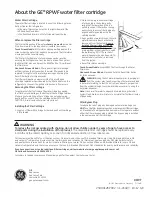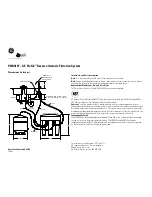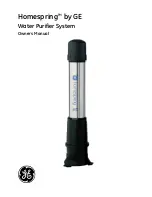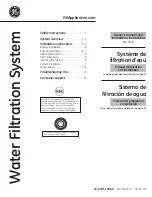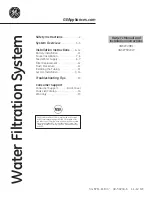
10
5. Open water supply saddle valve and let RO system fill with water. For ROC101E models,
the booster pump should start pumping immediately. Check for leaks on all internal and
external joints and repair any leaks by reseating the tube in the fitting, if necessary.
6. Let the system operate for about 20 minutes. Open the faucet and run water for about 10
seconds. Check for leaks again and repair if necessary. Re-install the Leak Stop device in
its normal position – first make sure there is no water or moisture in this location.
7. The system is now operating and filling the storage tank. Allow the tank to fill completely
and the system to automatically shut itself off. This step may take ½ to 1 hour or more.
Open the faucet and let the entire tank drain completely. You may see dark carbon dust
briefly flush from the carbon polishing cartridge – this is harmless and normal for the first
flow of water through the cartridge. Allow the system to re-fill the tank. Once completed,
your system is ready for use.
8. Reinstall the cabinet detachable lid and cowling. See Figure 5b. Replace the rear screw
and slide the RO cabinet into its final installation position.
Section 3: Operation and Maintenance
Operation of your Fusion 360 RO System is simple and easy. This appliance is fully automatic
and can be enjoyed without complicated operating procedures. Be sure to follow the cartridge
replacement schedule to ensure peak performance and long membrane element life.
T
otal
D
issolved
S
olids can be measured by simply pushing the button on the face of the cabinet
and observing the online TDS monitor. This monitor measures the TDS of the system’s product
water, indicating levels in excess of 100 TDS with a red light. At this level, a membrane failure
would be evident and a red light will show.
Soft water free from iron is idea for long membrane
life. Hardness, iron, chlorine and infrequently changed filter cartridges are the membrane’s
greatest enemies.
Changing the batteries on your TDS meter
You may change the two ‘AA’ sized batteries by removing the cabinet cowling and the detachable
lid. The battery case is located in the lower tray, towards the rear of the unit.
Changing Filter Cartridges
The pre and post filter cartridges should be changed, as a rule of thumb, every three to six months,
depending on local raw water conditions.
1. See Figure 5a above. Using the Phillips-head screwdriver, remove the screw as shown.
This will allow you to slide off the cabinet cowling from the rear. The top detachable cover
may also be removed by sliding it out towards the rear. See Figure 5b.
2. Filter cartridges must be changed with the saddle valve OFF.
3. Close the tank valve. Open the faucet until the flow of water stops, and then close.
4. Detach the Leak Stop device from the base of the RO cabinet to assure that it does not get
wet during the cartridge change process.
Summary of Contents for Fusion 360
Page 14: ...14 ...

















